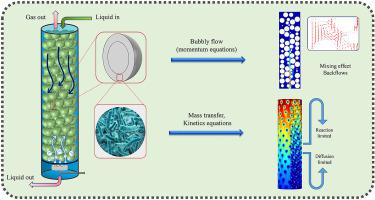Chemosphere ( IF 8.8 ) Pub Date : 2020-07-20 , DOI: 10.1016/j.chemosphere.2020.127680 Mohammad Abbasi 1 , Javad Aminian-Dehkordi 1 , Seyyed Mohammad Mousavi 1

|
Fe (II) biooxidation has recently gained significant interest. It plays a key role in a number of environmental and industrial processes such as bioleaching, acid mine drainage treatment, desulphurization of sour gases, and coal desulphurization. In this work, a three-dimensional CFD model for gas-liquid flow in a lab-scale packed-bed biooxidation reactor is used. The reactor is randomly packed with spherical particles, and the particles are covered with Leptospirillum ferrooxidans biofilm for Fe (II) biooxidation. A modified Jodrey-Tory algorithm is used to generate random packing with actual porosity of 0.42, and biofilm layer with constant thickness is considered over the particles. A simplified Eulerian–Eulerian model is used to obtain detailed flow field. The concentration profile in the reactor and the conversion of Fe (II) from the present simulations are obtained and validated using experimental data reported in the literature. The results of the study indicate that about three-quarters of the conversion occurs in the upper half of the reactor and Fe (II) concentration on the biofilm surface at the lower quarter of the reactor does not exceed 5 mM (The inlet concentration is 89.6 mM). The findings reveal that rate-limiting phenomena may vary in different parts of the reactor. The results obtained through the simulations represent advantages for the design and optimization of packed-bed biofilm reactors.
中文翻译:

一种新颖的计算模拟方法,用于研究填充床生物氧化反应器中生物膜的重要性。
Fe(II)生物氧化最近引起了人们的极大兴趣。它在许多环境和工业过程中发挥着关键作用,例如生物浸出,酸性矿山排水处理,酸性气体脱硫和煤脱硫。在这项工作中,使用了实验室规模填充床生物氧化反应器中气液流动的三维CFD模型。反应器随机装满球形颗粒,并且颗粒被铁氧化钩端螺旋体覆盖Fe(II)生物氧化的生物膜。修改后的Jodrey-Tory算法用于生成实际孔隙率为0.42的无规堆积,并在颗粒上考虑具有恒定厚度的生物膜层。简化的欧拉-欧拉模型用于获得详细的流场。利用文献报道的实验数据,获得并验证了反应器中的浓度分布图和根据本模拟得到的Fe(II)的转化率。研究结果表明,大约四分之三的转化发生在反应器的上半部,反应器下部的生物膜表面上的Fe(II)浓度不超过5 mM(入口浓度为89.6)毫米)。该发现表明限速现象可能在反应器的不同部分中变化。


























 京公网安备 11010802027423号
京公网安备 11010802027423号